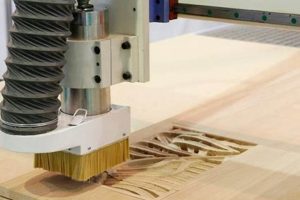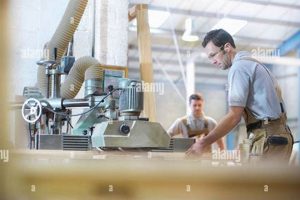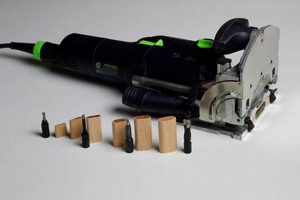A specialized tool employed in woodworking, this equipment facilitates the creation of precise holes in wood materials. These tools utilize rotating drill bits to bore through the wood, allowing for tasks such as creating pilot holes for screws, forming mortises for joinery, or producing decorative features. Examples range from handheld portable models for small projects to stationary floor-standing units designed for larger-scale production.
The utility of these devices in woodworking is significant. They enhance accuracy and efficiency compared to manual methods, allowing for repeatable results and reduced risk of material damage. Historically, advancements in drilling technology have paralleled the evolution of woodworking practices, enabling more complex designs and stronger construction techniques. The power and precision provided improves the quality and durability of finished wood products.
Subsequent sections will delve into various types of this equipment, explore critical features to consider during selection, and detail best practices for safe and effective operation. The goal is to furnish a comprehensive understanding of the role it plays in modern woodworking.
Operational Guidance for Wood Drilling Equipment
The following guidelines are presented to optimize the use of wood drilling equipment and enhance project outcomes. Strict adherence to these recommendations will contribute to both the quality of workmanship and the safety of operation.
Tip 1: Secure Workpiece Fixation: Prior to initiating any drilling operation, ensure the workpiece is firmly clamped or otherwise secured to the work surface. Movement during drilling can compromise accuracy and pose a safety hazard.
Tip 2: Select Appropriate Drill Bit: Utilize drill bits specifically designed for wood. Twist drill bits, brad point bits, and forstner bits each serve distinct purposes. The selection should align with the type of hole and desired finish.
Tip 3: Implement Correct Speed Setting: Adjust the drill’s speed based on the wood type and drill bit size. Harder woods and larger diameter bits typically require slower speeds to prevent burning or bit binding.
Tip 4: Apply Consistent Pressure: Maintain a steady and even pressure during drilling. Avoid forcing the bit, as this can lead to splintering, cracking, or premature bit wear.
Tip 5: Clear Debris Regularly: Periodically clear wood shavings and debris from the drilling area. Accumulated debris can obstruct visibility and impede the smooth operation of the drill bit.
Tip 6: Employ Pilot Holes for Accuracy: When precision is paramount, pre-drill pilot holes, especially for screws. This ensures accurate placement and prevents wood splitting.
Tip 7: Consider Backer Boards: When drilling through thin materials, place a backer board behind the workpiece to minimize tear-out and produce a clean exit hole.
These guidelines, when consistently applied, will result in more efficient, precise, and safer utilization of wood drilling equipment. The adherence improves project results.
The subsequent sections will detail the best selections for wood drilling applications.
1. Drill Bit Selection
The effectiveness of a woodworking drilling machine is intrinsically linked to the selection of an appropriate drill bit. The correct choice directly impacts the quality of the hole produced, the efficiency of the drilling process, and the longevity of both the machine and the bit itself.
- Material Compatibility
Different drill bits are designed for specific wood types. High-speed steel (HSS) bits are suitable for softer woods, while carbide-tipped bits excel in hardwoods and manufactured materials like plywood. Selecting an incompatible bit can result in premature wear, poor hole quality, or even bit breakage.
- Hole Type and Size
The intended use of the hole dictates the type of bit required. Twist drill bits are general-purpose, while brad-point bits provide cleaner entry and exit holes. Forstner bits are employed for creating flat-bottomed holes, and hole saws are used for large-diameter holes. The size of the bit must precisely match the dimensions needed for the intended application, such as screw placement or dowel insertion.
- Bit Geometry and Cutting Angle
The geometry of the drill bit, including its point angle and flute design, influences its performance. A steeper point angle is better suited for hard materials, while a shallower angle is more appropriate for softer materials. The flutes evacuate chips and debris from the hole, and their design affects the efficiency of this process.
- Maintenance and Sharpening
The condition of the drill bit directly affects its performance. Dull bits require more force to cut, increasing the risk of splintering or burning the wood. Regular sharpening is necessary to maintain optimal cutting efficiency and extend the life of the bit. Proper storage protects the bit from damage and corrosion.
Ultimately, the careful selection and maintenance of drill bits are critical for maximizing the potential of any woodworking drilling machine. This selection ensures clean, accurate holes, minimizes material damage, and promotes both efficiency and safety in the woodworking process.
2. Speed Control
Speed control is an integral function of the woodworking drilling machine, governing the rotational velocity of the drill bit. The rate of rotation profoundly influences the quality of the drilled hole, the efficiency of the drilling process, and the longevity of the tool. Inadequate speed selection can lead to material damage, compromised accuracy, and premature wear of both the drill bit and the machine itself. For example, excessive speed when drilling hardwoods can generate excessive heat, resulting in burning and bit dulling, while insufficient speed in softer woods might cause tearing rather than clean cutting. This delicate equilibrium is a fundamental aspect of proper drilling technique.
Modern woodworking drilling machines often incorporate variable speed control mechanisms, allowing operators to optimize the rotational velocity for specific materials and bit sizes. The operator can adjust the rotation velocity as needed by understanding the optimal settings. Drilling large-diameter holes generally requires lower speeds to prevent overheating and maintain control, while smaller pilot holes can be drilled at higher speeds for efficiency. Advanced features, such as electronic speed control, maintain constant speed under varying loads, ensuring consistent performance even when encountering dense knots or inconsistencies in the wood. This level of control enhances precision and reduces the risk of errors, contributing to a higher quality finished product.
In conclusion, speed control is a critical parameter in the operation of woodworking drilling machines. Its proper management is essential for achieving optimal drilling performance, minimizing material waste, and ensuring the safe and efficient utilization of equipment. Understanding the relationship between speed, material, and bit type is paramount for any woodworker seeking professional results. Failing to prioritize this aspect of operation can lead to subpar outcomes and increased operational costs.
3. Workpiece Stability
Workpiece stability is fundamental to the effective and safe operation of any woodworking drilling machine. The absence of secure fixation introduces a cascade of potential problems, directly affecting accuracy, finish quality, and operator safety. Without adequate stabilization, the workpiece may shift during the drilling process, leading to misaligned holes, inconsistent depths, and enlarged or misshapen openings. This is particularly critical when executing intricate patterns or performing repetitive drilling tasks where uniformity is paramount. For instance, constructing a cabinet requires precisely aligned holes for hinges and hardware; any movement during drilling compromises the structural integrity and aesthetic appeal of the finished product.
The causes of instability range from inadequate clamping to insufficient support for the workpiece. Vibration induced by the drilling machine can exacerbate the problem, especially when working with lightweight or irregularly shaped materials. Addressing these factors requires a combination of appropriate clamping devices, such as vises, toggle clamps, and specialized jigs, as well as the implementation of support structures to minimize movement. The use of a drill press, a type of woodworking drilling machine, inherently improves stability compared to handheld drills due to its stationary nature and integrated clamping mechanisms. Practical examples include securing long boards with outfeed supports to prevent sagging during drilling and utilizing sacrificial backer boards to minimize tear-out and stabilize thin workpieces.
In conclusion, achieving optimal results with a woodworking drilling machine necessitates a rigorous focus on workpiece stability. Failure to ensure adequate fixation undermines the precision and quality of the work, potentially leading to costly errors and hazardous working conditions. Addressing the causes of instability through appropriate clamping, support structures, and equipment selection is therefore an indispensable element of sound woodworking practice. Prioritizing stability translates directly to improved accuracy, enhanced safety, and ultimately, a superior finished product.
4. Depth Adjustment
Depth adjustment on a woodworking drilling machine governs the precise vertical travel of the drill bit, thereby controlling the depth of the resulting hole. This is a critical function, directly impacting the integrity of woodworking projects requiring specific hole depths, such as blind holes for joinery, shelf pin placement, or controlled mortise creation. Inadequate depth control can lead to holes that are too shallow, compromising structural integrity, or holes that are too deep, potentially damaging underlying components or creating unsightly through-holes. The accuracy afforded by a properly calibrated depth adjustment mechanism is essential for achieving professional-quality results. An example is the creation of precisely sized mortises; too shallow, and the tenon joint will be weak; too deep, and the joint will have excessive play. Precise depth adjustment mitigates such problems.
Various mechanisms facilitate depth adjustment, ranging from simple mechanical stops to more sophisticated digital readouts. Mechanical stops, often found on drill presses, provide a physical barrier that limits the downward travel of the drill bit. Digital readouts, commonly integrated into advanced drilling machines, offer precise measurement and control, enabling repeatable drilling depths with minimal error. The practical significance of depth adjustment extends beyond mere hole creation; it enables complex woodworking techniques such as plug cutting, where precise depths are crucial for creating seamless repairs or concealing screw heads. Similarly, when drilling for dowel joinery, consistent depth is essential for ensuring flush alignment of the joined pieces.
In summary, depth adjustment is an indispensable component of any woodworking drilling machine. Its functionality enables precise control over hole depth, which is essential for the successful execution of various woodworking tasks. Understanding the different depth adjustment mechanisms and their proper application is critical for achieving accuracy, consistency, and professional-quality results. While challenges such as calibrating mechanical stops and interpreting digital readouts exist, mastering these skills is paramount for any woodworker seeking to maximize the potential of the woodworking drilling machine.
5. Power Source
The power source is a fundamental determinant of the capabilities and application scenarios for woodworking drilling machines. It defines the operational characteristics, portability, and overall performance of the tool.
- Corded Electric
Corded electric drilling machines derive power from a direct connection to an electrical outlet. This provides a consistent and sustained power supply, suitable for extended periods of heavy-duty drilling. A common application is in stationary drill presses, where continuous operation is paramount. The limitation is tethered mobility, restricting the machine to areas with accessible power outlets.
- Battery-Powered (Cordless)
Battery-powered, or cordless, drilling machines utilize rechargeable batteries as their power source. The primary advantage is portability, enabling operation in locations without immediate access to electrical outlets. This is beneficial for on-site construction or remote woodworking projects. The runtime is limited by battery capacity, and sustained high-load operation may necessitate battery changes or increased recharge times. Battery technology is rapidly evolving, leading to increased power density and longer runtimes.
- Pneumatic (Air-Powered)
Pneumatic drilling machines are powered by compressed air supplied by an external compressor. These tools are known for their high power-to-weight ratio and durability. They are often found in industrial settings where a central compressed air system is available. Pneumatic tools are less susceptible to overheating compared to electric models, but require the logistical considerations of maintaining an air compressor and air lines.
- Hydraulic
Hydraulic drilling machines are used in specialized industrial woodworking applications. Hydraulic power is delivered via pressurized hydraulic fluid, providing high torque and power. These are often employed in large-scale timber processing or specialized manufacturing where their substantial force is required for drilling hardwoods or engineered wood products. The complexity and infrastructure requirements are higher than other power source options.
The choice of power source profoundly impacts the practicality and suitability of a woodworking drilling machine for a specific task. Factors such as project location, power requirements, portability constraints, and operational intensity must be considered to determine the optimal power source for the application.
6. Maintenance
Scheduled maintenance is an indispensable element in prolonging the operational lifespan and ensuring the consistent performance of any woodworking drilling machine. The intricate mechanical components are subject to wear and tear from repeated use, exposure to wood dust, and the stresses inherent in drilling operations. Failure to implement a structured maintenance regime invariably leads to diminished accuracy, increased downtime, and potentially, catastrophic equipment failure. For instance, neglecting to lubricate the spindle bearings on a drill press can result in increased friction, overheating, and eventual seizure, rendering the machine inoperable. Similarly, the accumulation of sawdust within the motor housing can impede cooling, leading to premature motor failure. Regular cleaning, lubrication, and inspection protocols are therefore essential for preserving the integrity of the machine and preventing costly repairs. These actions ensure the machine continues to provide the precision required in woodworking applications.
The scope of maintenance extends beyond mere cleaning and lubrication. It encompasses periodic inspection and adjustment of critical components. Drill presses, for example, require regular checking and adjustment of the belt tension to maintain optimal power transfer and prevent slippage. The table and fence alignment must also be verified periodically to ensure accurate drilling angles and depths. Additionally, the electrical system should be inspected for frayed wires or loose connections, as these can pose a safety hazard. The operator should routinely sharpen or replace dull drill bits, as dull bits place undue stress on the machine’s motor and increase the risk of kickback. The frequency of these maintenance tasks depends on the machine’s usage intensity and the type of materials being processed. High-volume production environments necessitate more frequent maintenance schedules compared to hobbyist workshops.
In summary, maintenance is not an optional addendum but a critical operational requirement for woodworking drilling machines. Its consistent application ensures long-term reliability, sustained accuracy, and enhanced safety. Challenges exist in implementing effective maintenance programs, including the need for trained personnel and the allocation of dedicated time. However, the long-term benefits, in terms of reduced downtime, lower repair costs, and improved work quality, far outweigh the initial investment. Prioritizing maintenance is, therefore, a sound strategic decision for any woodworking operation, safeguarding the integrity of the equipment and maximizing its productive potential.
Frequently Asked Questions
The following addresses frequently asked questions concerning the selection, operation, and maintenance of woodworking drilling machines. The information is intended to provide clarity on common issues and misconceptions.
Question 1: What distinguishes a woodworking drilling machine from a metalworking drilling machine?
Woodworking drilling machines are typically optimized for higher speeds and lower torque, appropriate for softer materials. Metalworking machines are engineered for lower speeds and higher torque to cut through harder metals. Using a metalworking machine on wood can result in burning and splintering, while using a woodworking machine on metal can lead to tool damage and ineffective cutting.
Question 2: What is the recommended method for preventing tear-out when drilling through wood?
Tear-out, or splintering, can be mitigated by using a backer board behind the workpiece. This provides support to the wood fibers as the drill bit exits, preventing them from tearing away. Furthermore, using brad-point drill bits, which are designed to create clean entry and exit holes, is advisable.
Question 3: What safety precautions are essential when operating a woodworking drilling machine?
Essential safety precautions include wearing appropriate eye protection, securing the workpiece with clamps or a vise, ensuring that the drill bit is properly tightened, and avoiding loose clothing or jewelry that could become entangled in the machine. Disconnecting the power source during bit changes and maintenance is also crucial.
Question 4: How frequently should drill bits be sharpened or replaced?
Drill bits should be sharpened or replaced when they exhibit signs of dullness, such as requiring excessive force to cut, producing rough or burnt edges, or creating excessive heat. The frequency depends on the type of wood being drilled and the intensity of use. Regular inspection of the cutting edges is recommended.
Question 5: What is the significance of variable speed control in a woodworking drilling machine?
Variable speed control allows the operator to adjust the rotational speed of the drill bit to match the material being drilled and the size of the bit. Lower speeds are generally appropriate for larger bits and harder woods to prevent overheating and maintain control, while higher speeds are suitable for smaller bits and softer woods to increase efficiency.
Question 6: What routine maintenance procedures are necessary for maintaining a woodworking drilling machine?
Routine maintenance procedures include regularly cleaning the machine to remove sawdust and debris, lubricating moving parts such as bearings and spindles, inspecting and adjusting belt tension (if applicable), and verifying the alignment of the table and fence. Periodic inspection of the power cord and electrical components is also essential.
Proper operation and maintenance are paramount to ensuring accuracy and extending the life of a woodworking drilling machine.
The next section will provide a glossary of relevant terms.
Conclusion
This exposition has explored the woodworking drilling machine from operational considerations to component specifics. Its utility in creating precise holes, critical for various woodworking techniques, has been underscored. The topics ranged from drill bit selection to workpiece stability, speed control, power sources and routine maintenance.
Mastery of the woodworking drilling machine, achieved through understanding its capabilities and limitations, empowers woodworkers to elevate the precision and quality of their craft. A continued commitment to safety and a dedication to refinement of technique will define the trajectory of future woodworking endeavors.




![Robland X31: The Ultimate Woodworking Machine [Review] Step-by-Step Guides, Tools & Inspiration to Build Beautiful Wooden Decor on a Budget Robland X31: The Ultimate Woodworking Machine [Review] | Step-by-Step Guides, Tools & Inspiration to Build Beautiful Wooden Decor on a Budget](https://woodfromhome.com/wp-content/uploads/2025/11/th-702-300x200.jpg)


